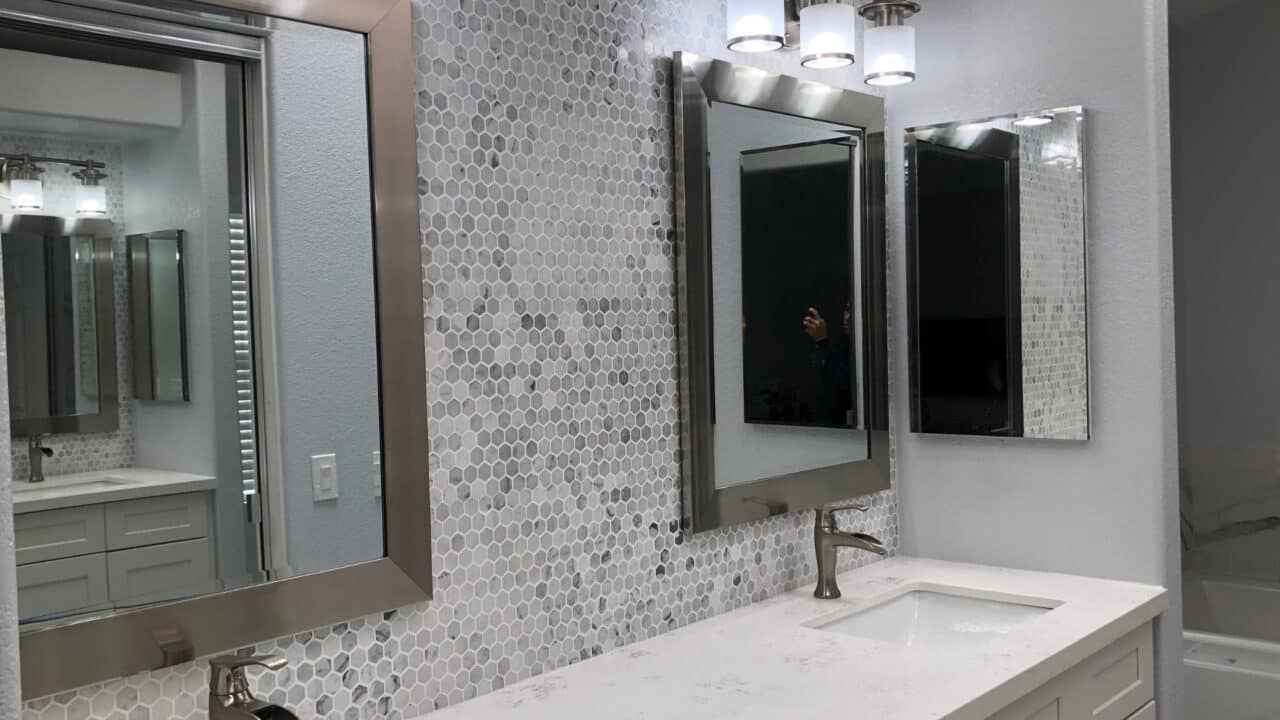🔑 Key Takeaway
A backsplash isn’t strictly required behind a bathroom vanity, but it can prevent water damage, mold, and messy walls — especially near sinks that get daily use. Whether you choose a vanity set with a matching backsplash or go custom with tile or caulk, it’s worth understanding when a backsplash adds real protection (and when it’s just for looks).
What Is a Vanity Backsplash?
A vanity backsplash is the short vertical barrier behind the sink that protects the wall from water splashes. It’s usually:
-
3–4 inches tall
-
Made from the same material as the countertop (stone, cultured marble, etc.)
-
Either attached to the countertop or installed separately against the wall
Some designs also include side splashes, especially for vanities in corners or tight alcoves.
🚫 Are Backsplashes Required by Code?
No — building codes do not require a backsplash behind a bathroom vanity. It’s considered a design choice, not a mandatory fixture like a GFCI outlet.
That said, if your vanity is located on a wall without tile or other water-resistant finishes, a backsplash is highly recommended to prevent future problems.
👍 When a Vanity Backsplash Is a Smart Idea
You have drywall behind the sink:
Drywall absorbs water quickly, leading to bubbling paint, soft spots, or mildew. A backsplash acts as a moisture barrier.
Kids or guests frequently use the bathroom:
The more splashing and sloppy hand-washing you expect, the more benefit you get from a backsplash.
Your vanity is in a tight space or corner:
Side splashes help protect adjacent walls from angled spray and elbow splashing.
You want to hide wall imperfections:
Backsplashes can neatly cover gaps, uneven cuts, or misaligned tile from older installs.
You’re installing a stone countertop:
Stone tops (granite, quartz, marble) are typically paired with matching 4″ backsplashes for visual cohesion and moisture protection.
👎 When You Might Skip the Backsplash
You have tiled or waterproofed walls:
If your wall is already protected with full-height tile or waterproof paint, a backsplash is more optional.
You’re going for a modern, minimalist look:
Floating vanities or vessel sink designs often intentionally skip the backsplash for a sleek, spa-style aesthetic.
You plan to tile the wall later:
If you’re adding a custom tile backsplash or full accent wall, skip the prefab version and tile flush to the counter instead.
🛠️ Backsplash Options (Prefab vs Custom)
Prefab (Included with Vanity Top):
-
Usually 3–4″ tall, same material as the top
-
Easy to install with adhesive and caulk
-
Great for quick installs or matching finishes
Custom Tile or Stone:
-
Lets you match bathroom decor or run tile up to a mirror or light
-
Can be as short as 4″ or go full wall height
-
Requires more labor but looks high-end
Caulk-Only Option:
-
For very small vanities or tiled walls, a tight silicone bead may be enough to protect the seam
-
Needs to be maintained and resealed every few years
🧼 Maintenance Considerations
-
Always caulk the joint between the backsplash and countertop
-
Clean regularly with non-abrasive cleaner to avoid damaging finishes
-
For natural stone, use a pH-neutral cleaner and seal annually if porous
💬 Frequently Asked Questions
Do I have to install the backsplash that came with my vanity?
No, you’re not required to use the included backsplash — it’s totally optional. Many vanity tops come with a matching 3–4″ backsplash, but whether you install it depends on your style preferences and how your bathroom is built.
Here are some things to consider:
-
If you’re aiming for a clean, modern look or planning to install a custom tile backsplash, you can skip the included piece.
-
If your wall is unfinished drywall or lacks tile behind the sink, that backsplash adds valuable water protection and is worth installing.
-
You can also mix materials, using a stone countertop with a tiled backsplash or vice versa — just make sure the transition looks intentional and is properly sealed.
Bottom line: the included backsplash is a helpful option, but not a must. If you skip it, just be sure to protect the wall with tile, waterproof paint, or a clean silicone bead.
Can I add a backsplash after the vanity is installed?
Yes, you can add a backsplash after your vanity and countertop are already in place — and it’s a common upgrade. In fact, many homeowners wait to decide on a backsplash until they see how the vanity looks in the space.
Here’s what to know:
-
You can attach prefab backsplashes (usually 3–4″ tall) directly to the wall with construction adhesive, then seal the edges with silicone caulk.
-
Custom tile backsplashes are also easy to install afterward and give you more design freedom — just make sure to prep the wall properly for tile or stone.
-
If your countertop is already caulked tightly to the wall, you may need to trim or remove the caulk before adding a backsplash to ensure a snug fit.
Adding one later is perfectly fine — just make sure to reseal the seams properly to keep water out and preserve your wall.
How tall should a bathroom backsplash be?
The standard height for a bathroom vanity backsplash is 3 to 4 inches, especially if it’s a prefab piece that comes with the countertop. This size offers basic splash protection while keeping the look clean and minimal.
However, custom backsplashes can be taller — even full wall height — depending on your design goals. For example:
-
Tile backsplashes often go up to the bottom of the mirror, light fixture, or even the ceiling for a bold, modern look.
-
Side splashes (used in corners or tight spaces) are usually the same height as the rear backsplash but can be extended if needed.
-
If you’re skipping tile altogether, a full-height backsplash in stone or quartz can act as both a protective surface and a design focal point.
Ultimately, the height is up to you — just make sure it covers the splash zone behind your sink and blends well with your bathroom’s overall aesthetic.
What if my countertop doesn’t come with a backsplash?
No problem, you’ve got options. Manufacturers often leave backsplashes off vanity tops so you can customize the look to match your bathroom style. If you still want protection behind the sink, you can:
-
Buy a matching backsplash kit (from the same brand or supplier) made from the same material as your countertop.
-
Install a custom tile backsplash for a more decorative or high-end look. This gives you the flexibility to run tile partway or all the way up the wall.
-
Use a silicone caulk bead if the vanity is tight to a waterproofed wall and you’re going for a seamless, minimalist appearance.
Keep in mind: you don’t need a backsplash, but you do need a moisture barrier. Without one, water can get into the gap between the wall and the countertop — so even a basic caulk line, when done right, adds crucial protection.
Is it okay to have no backsplash at all?
Yes, you can skip a backsplash, as long as you’ve protected the wall behind your sink. Tile, waterproof paint, or other moisture-resistant finishes hold up well against everyday splashes. Many designers even leave the backsplash out on purpose to create a clean, minimalist look.
However, if your vanity sits against unfinished drywall, skipping a backsplash can lead to trouble. Water splashes from handwashing can soak into the wall, causing bubbling paint, mildew, or long-term damage. If you’re not adding tile, apply a small bead of high-quality silicone caulk along the back edge to seal out moisture. Check it regularly and reapply as needed to keep the seal strong.
In short: no backsplash works best when the wall can handle some water. Otherwise, adding one is cheap insurance against damage.

